The Impact of Custom GPTs: An Overview of Their Key Applications
ChatGPT has fundamentally changed the way we can tackle a broad array of tasks, introducing unprecedented levels of automation and intelligence into our workflows. However, leveraging this technology effectively often hinges on the user’s ability to craft precise and insightful prompts – a skill not everyone possesses. Recognizing this barrier, OpenAI introduced custom GPTs last year, offering a solution that partially addresses this challenge.
The specialized versions of GPT come pre-configured to perform specific functions, eliminating the need for intricate prompt engineering by the user. Beyond their tailored functionality, many custom GPTs are enhanced with the ability to access various knowledge bases and websites via API calls, significantly expanding their utility and application.
As we delve into the popular use cases for the custom GPTs, we uncover the breadth and depth of their impact across different sectors, showcasing their potential to further revolutionize how we engage with artificial intelligence in our daily lives and professional activities.
If this in-depth educational content is useful for you, subscribe to our AI mailing list to be alerted when we release new material.
Top Use Cases Across Different Categories
Custom GPTs are specifically crafted to serve a wide range of purposes, from generating content to conducting intricate analyses. The diversity of their applications highlights the versatility and adaptability of GPT technology, providing not just innovative but also deeply practical solutions. Through examining these various categories, the profound influence of GPT technology on numerous industries becomes apparent, illustrating how it fuels improvements in efficiency, sparks creativity, and enhances personalization.
Writing
In the realm of writing, custom GPTs have become invaluable assets. By automating the creation of content, these AI tools enable writers to produce work that is not only high in quality but also diverse in scope. From generating SEO-optimized articles to crafting compelling ad copy, the application of custom GPTs in writing showcases the technology’s ability to adapt to specific linguistic styles and content requirements, ensuring that the output is both engaging and tailored to meet the audience’s needs.
- High-quality Articles: Custom GPTs designed for writing are at the forefront of content creation, focusing on producing tailored, engaging content. They prioritize quality, relevance, and adherence to specific word counts, making them indispensable for content marketers and publishers.
- Humanizing Content: A subset of writing GPTs excels in “humanizing” AI-generated content, ensuring the output sounds natural and not machine-generated.
- SEO Optimization: These GPTs specialize in creating content optimized for search engines, incorporating SEO strategies seamlessly into articles, blogs, and web content to improve visibility and ranking.
- Ad Copywriting: Tailored for marketing, these GPTs generate persuasive, brand-aligned ad copies that capture attention and drive conversions.
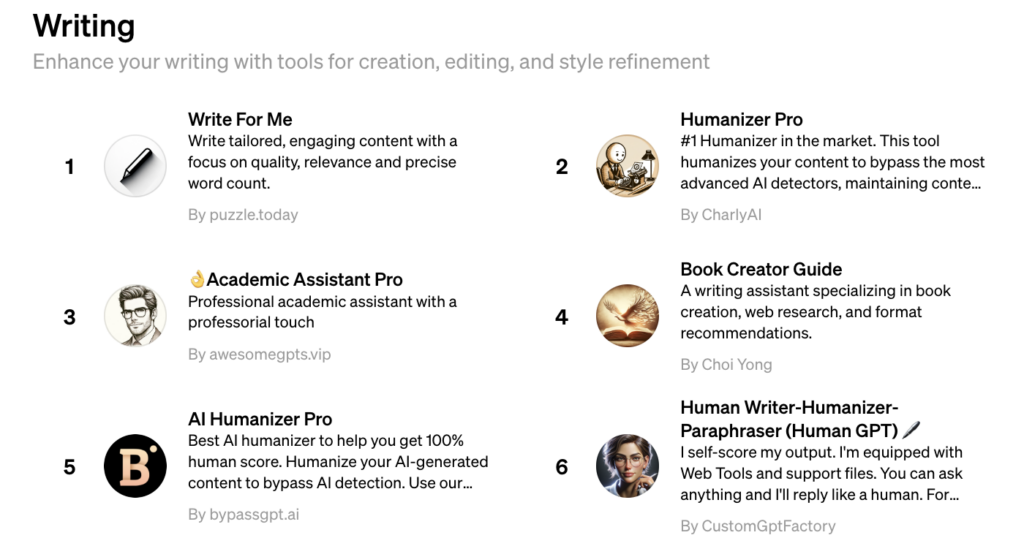
Visuals
The visual category of custom GPT applications brings a new dimension to creativity and design. By leveraging AI, these tools enable the creation of stunning visuals, from personalized logos to mood boards and stylized images. This not only simplifies the design process but also opens up new possibilities for visual expression, allowing for the creation of unique and captivating visual content that stands out in a crowded digital landscape.
- Image Generators: Specialized in generating and refining images, these GPTs produce visuals for a wide range of applications, from marketing to personal projects.
- Logo Creators: These GPTs streamline the logo design process, offering personalized, brand-centric logo designs that resonate with the target audience.
- Stylization Tools: Transforming photos into cartoon versions, drawings into oil paintings, or digital images into real-life photos, these GPTs power creativity and enhance the productivity of artists and designers.
- Mood Board Designers: Aiding in visual brainstorming, the GPTs can create mood boards that inspire creativity and guide projects’ visual direction.
- AI Persona Creators: These GPTs design detailed AI personas and generate the corresponding characters in different poses, expressions, and scenes.
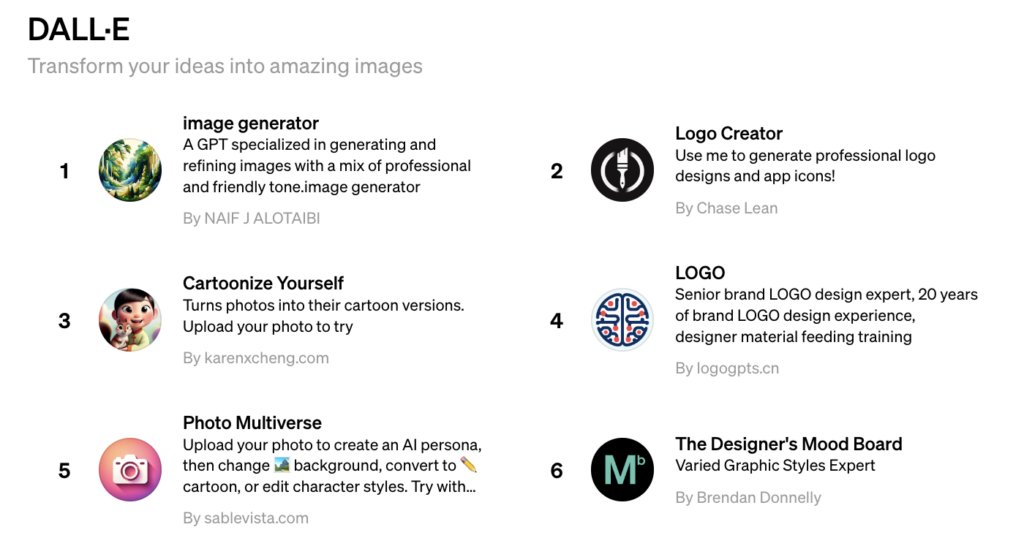
Productivity
Custom GPTs tailored for productivity applications are changing the way we approach tasks and project management. From designing presentations to creating complex infographics, and interacting with PDF documents, these AI tools offer solutions that streamline processes, enhance creativity, and improve efficiency.
- Presentation and Social Media Post Designers: Enhancing efficiency in creating visually appealing presentations and social media content, these GPTs offer design solutions that save time and improve aesthetic appeal.
- Diagram Generators: These GPTs specialize in creating diagrams, flowcharts, and visualizations, enhancing clarity in presentations and documentation.
- AI Video Makers: The GPTs from this category can assist with generating videos for social media, incorporating AI avatars, music, and stock footage, and streamlining content creation for digital marketing.
- PDF Communicators: The GPTs from this category allow users to chat with their PDFs, facilitating easy access and management of documents.
- Text-to-Speech Tools: Powered by ElevenLabs and similar tools, such GPTs can convert text to natural-sounding speech, broadening accessibility and enhancing user engagement.

Research & Analysis
Custom GPTs can offer unparalleled support in data interpretation, academic research, and market analysis. These AI assistants can sift through vast amounts of information, providing insights and conclusions that would take humans considerably longer to derive. Their ability to access and analyze data from diverse sources makes them invaluable for researchers, analysts, and anyone in need of deep, data-driven insights.
- AI Research Assistants: Accessing academic papers from various sources, these GPTs synthesize and provide science-based responses, aiding in research and academic writing.
- Computational Experts: Wolfram GPT and other similar tools offer computation, math, and real-time data analysis, supporting complex problem-solving and analysis.
- Trading Analysis Assistants: Specializing in financial markets, these GPTs predict stock market trends and prices, aiding investors in making informed decisions.
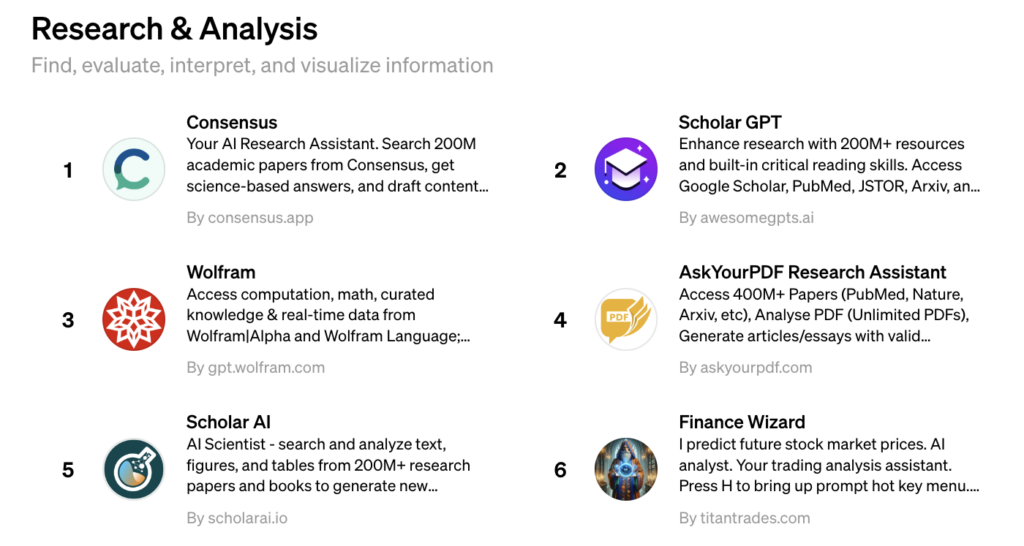
Programming
Custom GPTs have also made a significant impact in the world of programming, offering assistance that ranges from tutoring beginners to aiding advanced developers in their projects. These AI tools can help debug code, suggest improvements, and even assist in building websites, making the process more efficient and accessible for everyone involved. The ability of these GPTs to adapt to various coding languages and frameworks showcases the versatility and depth of their programming capabilities.
- Coding Assistants: Catering to both beginners and advanced coders, these GPTs facilitate coding, debugging, and learning, enhancing productivity and learning in software development.
- Website Builders: Focusing on web development, these GPTs streamline website creation, offering intuitive design and development tools that simplify the web-building process.
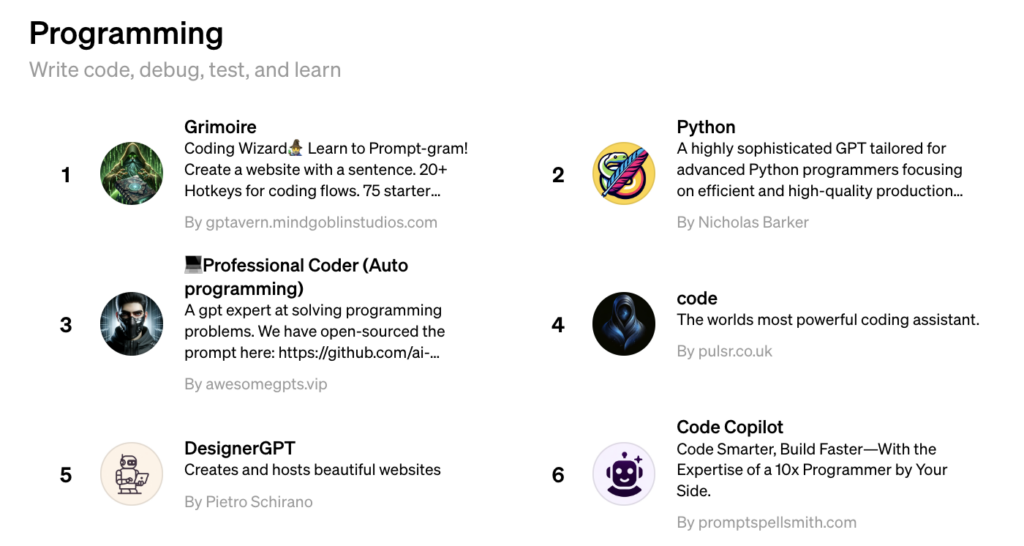
Education
In the field of education, custom GPTs are revolutionizing the way knowledge is imparted and received. From providing personalized tutoring sessions to transforming digital content into comprehensive study guides, these AI tools make learning more accessible and engaging for students of all ages. Their ability to tailor educational content to individual learning styles and needs marks a significant step forward in educational technology.
- AI Tutors: Including offerings from Khan Academy, these GPTs personalize learning, providing tutoring in various subjects to enhance education.
- Math Solvers: Specializing in math tutoring, these assistants offer step-by-step solutions and explanations, supporting students’ learning journeys.
- Transcripts & Notes-Taking Tools: Transforming digital content into study guides or summaries, these GPTs aid in education and personal knowledge management.
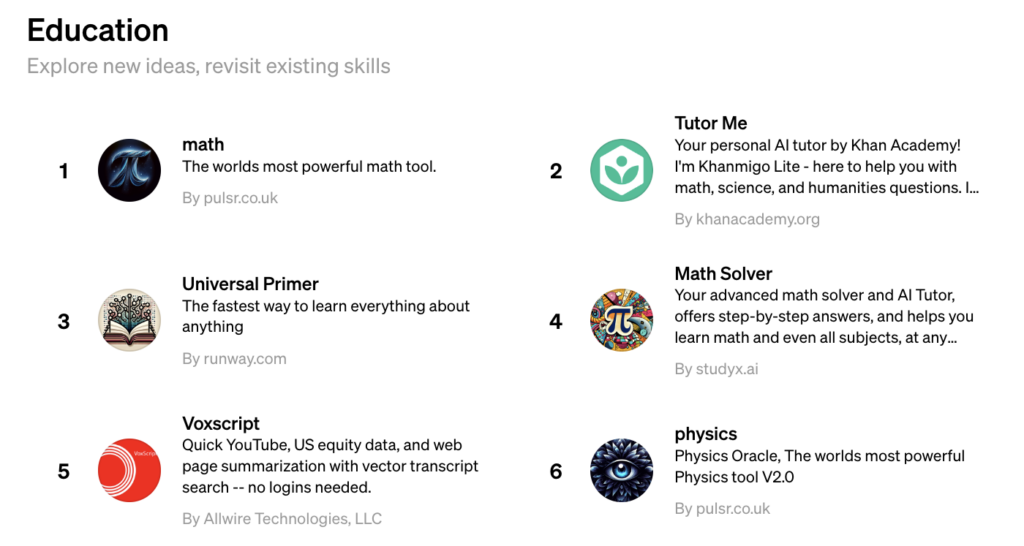
Lifestyle
The application of custom GPTs extends into the lifestyle sector, offering personalized advice and assistance in areas such as fitness, travel, food, and dating. These AI tools help individuals make informed decisions, enhance their daily routines, and explore new experiences with confidence. From creating workout plans to crafting compelling dating messages, custom GPTs in the lifestyle category enrich lives in diverse and meaningful ways.
- Workout Planners: Tailoring fitness plans to individual needs, these GPTs offer personalized workout routines, enhancing health and fitness.
- Travel Guides: Offering personalized travel recommendations and guidance, these GPTs enhance the travel planning process, making it more enjoyable and informed.
- Food Tips: From recipes to nutritional advice, these GPTs cater to culinary interests, supporting healthier eating habits and culinary exploration.
- Dating Message Experts: Aiding in online dating, these GPTs offer advice on crafting engaging and appropriate messages, improving users’ dating experiences.
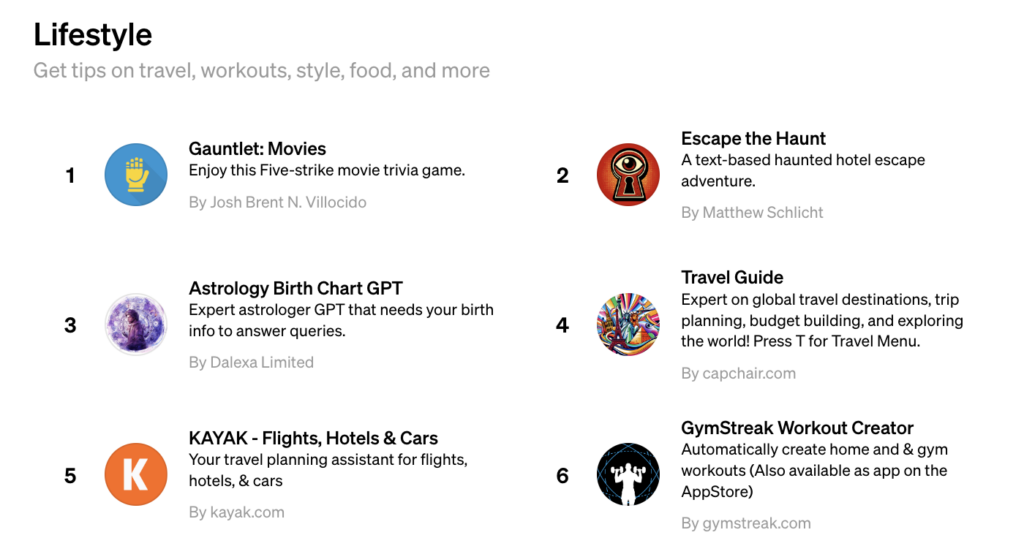
Looking Ahead: The Future Impact of Custom GPTs
The advent of custom GPTs has opened up new opportunities in the application of artificial intelligence across a multitude of sectors. These specialized tools are not just enhancing how we work, create, and learn; they are redefining the possibilities of AI-driven assistance. With their tailored functionalities and the ability to tap into vast knowledge bases, custom GPTs stand at the forefront of a technological revolution, making sophisticated tasks more accessible and streamlined than ever before. As we continue to explore and expand their capabilities, the potential of custom GPTs to transform our daily lives and professional environments is boundless.
Enjoy this article? Sign up for more AI research updates.
We’ll let you know when we release more summary articles like this one.
The post The Impact of Custom GPTs: An Overview of Their Key Applications appeared first on TOPBOTS.